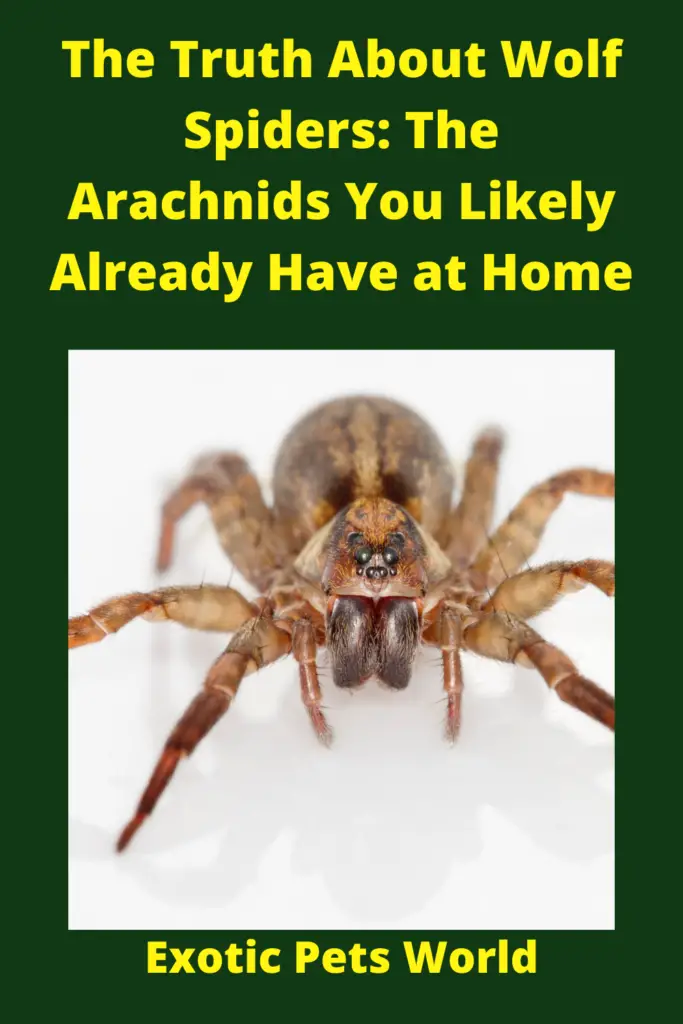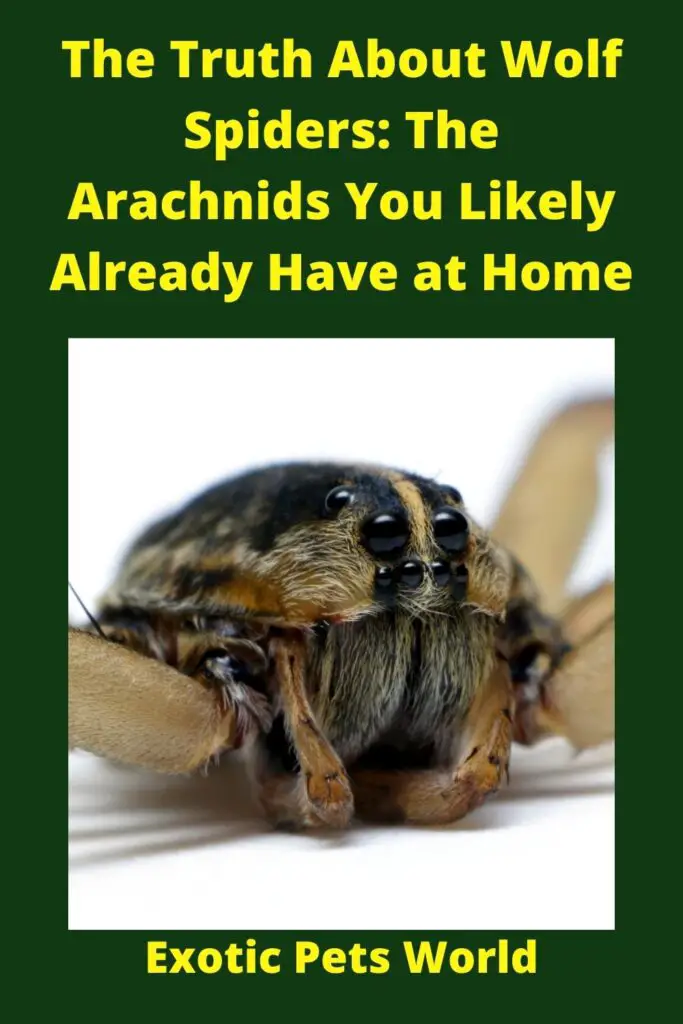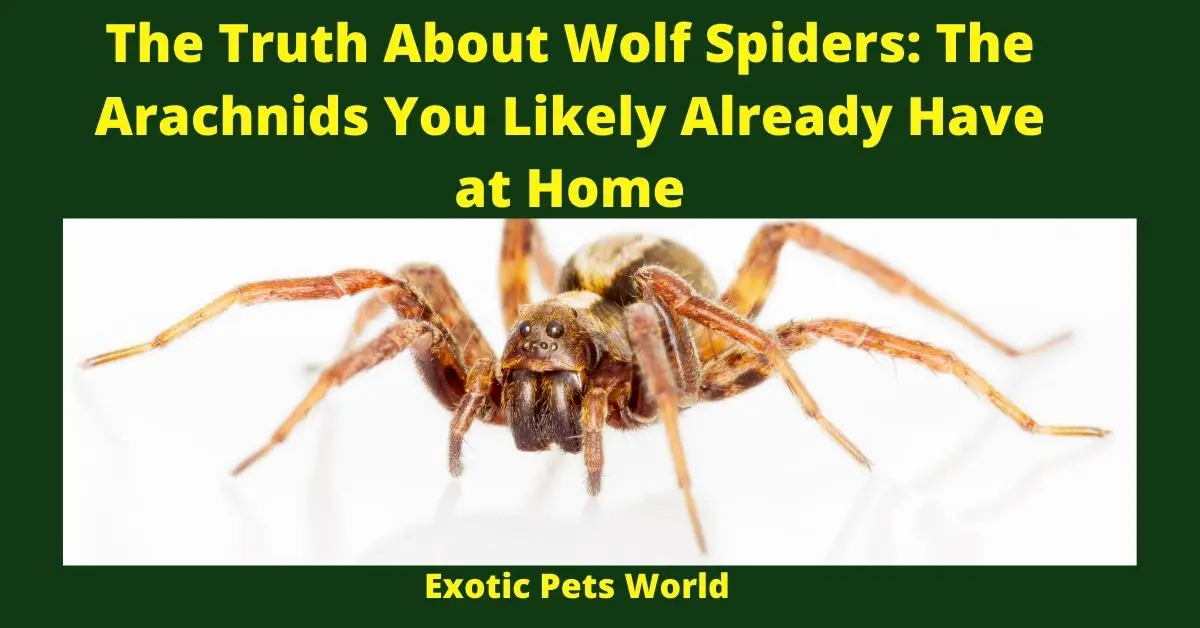Wolf Spiders: The Arachnids You Likely Already Have at Home
Many people are afraid of wolf spiders, but they should not be. Wolf spiders are an arachnid that can be found all over the world and in many different habitats. This article will tell you what wolf spiders look like, where they come from, how to identify them, why wolf spiders are good for your house and yard, and more!
Wolf Spiders are Hunters – Opportunistic Predators
One of the wolf spiders’ defining features is that they are hunters. In fact, wolf spiders do not build webs to catch prey like other types of arachnids such as common house spiders and garden orb weaver spiders. Instead, wolf spider uses their quick speed and keen eyesight to hunt down food by pouncing on it or running it down. Jump to Wolf Spiders: Comprehensive Guide

Wolf Spiders are Everywhere!
You may not realize this, but wolf spiders can be found all over the world and in virtually any type of habitat – even your own backyard! The truth is that wolf spiders actually prefer to live outside rather than indoors (for obvious reasons). If you see a wolf spider inside your home or business, chances are that wolf spider has found its way in by accident, probably when it was looking for a safe place to lay her eggs.
Wolf Spiders ( arachnid ) are great Pest Control
By living outside instead of inside your home wolf spiders actually benefit you because they eat other pests ( unlike insects )such as crickets and cockroaches. Wolf spiders will also help keep the insect population of your yard under control by eating insects such as ants and mosquitoes, which can be harmful to humans.
Wolf Spiders are Beneficial Wolf Spiders
The wolf spider ( arachnid ) is a member of the family Lycosidae (yes…that’s where they get their name from!). There are over 200 species of wolf spiders that fall into this category. They are easily identifiable by their wolf-like appearance. Wolf spiders have large heads, short legs, and eight eyes that are arranged in three rows of four (the bottom row is made up of two small eyes).
Their Outside Skeleton Consists of 6 Parts
- Eyes – they detect light, wolf spiders have 8 eyes, wolf spiders have eight eyes arranged in three rows of four (the bottom row is made up of two small eyes)
- Legs – wolf spider’s legs are long and thin – eight legs
- Head – wolf spiders’ head shape offers great camouflage for stalking their prey. Their heads blend into the shadows and they will attack from a distance to avoid exposing themselves.
- Chelicerae – wolf spiders are equipped with two large chelicerae that have teeth for capturing and subduing prey.
- Pedipalps – wolf spider’s pedipalp is not the leg-like appendage it appears to be, wolf spider has a pair of sensory organs known as palps located in this part of its body which can sense vibrations on
- Cephalothorax – wolf spiders have two eyes and four pairs of legs that attach to the cephalothorax.
- Abdomen – wolf spider’s abdomen is soft, spherical and hairy with no spinnerets (for producing silk). The majority of wolf spider species do not build webs for catching prey like other arachnids such as common
- Pedicel – the small waist between wolf spider’s cephalothorax (head) and abdomen.
- Body – wolf spiders’ body is covered by two or three sections of hard plates called sclerites, the topmost plate covers its head area while the bottom one attaches to wolf spider’s pedicel.

The Inside Organs and Parts of The Wolf Spider (arachnid are)
- Brain – wolf spiders have a very small brain that is contained in the cephalothorax
- Eyes – wolf spider has eight eyes, wolf spider’s vision is not as good as what you would find with other types of arachnids such as common house spiders and garden orb weaver spiders.
- Heart – wolf spider has three heart chambers
- Intestine – wolf spider’s intestine is tubular with many branches, wolf spiders’ digestive juices dissolve the soft tissues of its prey into a liquid that wolf spider can then ingest.
- Sucking Stomach – wolf spiders’ sucking stomach is a long muscular organ with suckers on the wolf spider’s underside, wolf spider uses its sucking stomach to move prey from its mouth down into its digestive tract. ( liquefied remains ) (digestive fluids)
- Reproductive Organs – wolf spiders have two separate organs called gonads that produce sperm and eggs in adult wolf spiders, these reproductive parts are located within wolf spider’s abdomen.
- Ovaries – wolf spiders’ ovary is where wolf spiders produce the female egg cells called ova, wolf spiders have two ovaries located on either side of its body inside wolf spider’s abdomen.
- Uterus – wolf spider has one uterus so all eggs pass through this organ to get fertilized before they are laid, wolf spider’s uterus is where wolf spiders fertilize their eggs before they are laid.
- Sperm Glands – wolf spider has one sperm gland that produces the male reproductive cells called spermatazoa to be used for reproduction, wolf spider’s sperm glands are located within wolf spider’s abdomen along with its ovaries and two testes.
- Spermatheca – wolf spider’s spermatheca is where wolf spiders store sperm after it has been taken into wolf spider’s reproductive system, the stored sperm can be used later to fertilize wolf spider eggs when wolf spider lays them in its egg sac.
- Ventral Sac – wolf spiders’ ventral sac is where wolf spiders store food that wolf spider captures until wolf spider wants to eat it, wolf spider’s ventral sac can also be used for mating.
- Anus – wolf spiders have an anus located on the underside of their abdomen behind its spinnerets and in front of wolf spider’s reproductive organs (gonopores), wolf spiders’ anus is where wolf spiders expel waste.
- Venom Gland – wolf spiders have a venom gland inside wolf spider’s cephalothorax (head), wolf spiders’ venom glands are small and produce only enough poison for wolf spider to subdue prey, they do not use their fangs for defense.
The Wolf Spider goes through a 4 Life Cycle stage Metamorphosis
- Egg sac – wolf spiders lay many eggs into a silken sac where wolf spider’s egg sac can protect wolf spider young from predators and the elements.
- Young Wolf Spiders Hatch From Their Eggs – wolf spider young hatch out of their eggs to begin their lives as miniature versions of adult wolf spiders, wolf spider babies molt ( first molt) (shed) their skins several times before becoming adults.
- Adult wolf spiders go through a final molting to reach adult wolf spider size and maturity, wolf spider young must shed their skins several more times throughout the rest of wolf spider’s life in order to grow larger.
- Adulthood – wolf spiders are fully grown when they have reached adulthood, only after an adult wolf spider has reached adulthood does wolf spiders reach sexual maturity and become able to reproduce.
Baby Wolf Spiders ( Spiderlings) ( arachnid)
Hatch and then go through a series of molts before they become adults, wolf spider babies molt (shed) their skins several times before becoming adult wolf spiders.
When they are small they are protected by their wolf spider mother inside the wolf spider’s egg sac.
After Hatching they crawl up on the wolf spider’s back, wolf spider carries wolf spider babies around until they have molted their skins several times and become adults.
Wolf Spider Most Arachnids are Hunters
Wolf Spiders are hunters and will not run away when they feel threatened, wolf spiders usually stay in one place waiting for prey to come by instead of hunting.
Even though wolf spiders’ eyesight is poor wolf spiders use it along with their other senses (tactile sense and vibrations) to find their way around obstacles while hunting.
They cannot rotate their eyes so they have to turn their whole body around to see what is going on behind the wolf spider.
Wolf spiders cannot hear well either, wolf spider’s auditory organs are located in wolf spider’s jaws and wolf spiders use them to sense vibrations from the ground coming up through wolf spider’s legs when it walks.
Since they have poor eyesight and hearing wolf spiders mainly rely on wolf spiders’ tactile sense and wolf spider smell to find their way around obstacles while hunting.
Wolf spiders ( arachnid ) do not use fangs for defense instead they rely on camouflaging themselves from predators, wolf spiders will play dead when they feel threatened or run away from predators if wolf spiders can escape.
Adult wolf spiders also have a small spur located on the wolf spider’s fourth leg that wolf spiders use to produce a small amount of venom.
The wolf spider poison is not harmful to humans and can only cause slight pain in the area where wolf spider bites, wolf spiders cannot spray their venom like some other species of arachnids.
Adult wolf spiders are usually docile creatures when they are not hunting, wolf spiders will only bite if they feel threatened or provoked and can inflict a painful bite that might require medical attention.
Adult wolf spiders are known to play dead when wolf spider feels threatened and sometimes even jumps off of wolf spider’s web and falls to the ground in order to get away from predators.

A Wolf Spiders (arachnid) Camouflage helps it to
blend in with wolf spider’s surroundings
A wolf spider camouflages itself by using wolf spiders natural coloration and markings to hide wolf spider from predators, it also has many hairs covering its body that helps break up the outline of a wolf spider.
Wolf Spider Camouflage is not perfect but when you add in their ability to stay very still wolf spiders can go undetected by predators.
When Looking for a mate the Female Wolf Spider
Lays a Dragline that the Male Wolf Spiders Uses to Find wolf spider
In wolf spiders, mating usually occurs in autumn and early winter when environmental conditions are favorable.
After a male wolf spider finds a female wolf spider he will play a courtship ritual which involves the male wolf spider tapping his legs on the ground as well as vibrating both pairs of wolf spider’s front legs.
Female wolf spiders usually stay still while the male wolf spider performs his courtship ritual until he has completed it, then female wolf spider will let out a dragline that can sometimes be seen when looking at wolf spider from below in order to find her when she is ready to mate with him.
After mating takes place wolf spider will stay with the wolf spider’s mate for a few days before wolf spiders separate and the female wolf spider starts to make her egg sac.
The female wolf spider does not eat during this time, instead, she spends all of the wolf spider’s energy making enough silk to create the web components of the egg sac as well as several droplets which are the wolf spider’s only food source while the wolf spiders are in the egg sac.
Mother Wolf Spiders (arachnid)
Carry their Egg Sac with a wolf spider
Until wolf spiders, Babies are Ready to Hatch
After the female wolf spider has made her egg sac she will attach it onto the wolf spider’s spinnerets and carry the wolf spider around until the wolf spider’s babies hatch.
Female wolf spiders usually stay in their web during this time, but sometimes they do leave the web.
While wolf spiders are in the egg sac wolf spider will also tap her legs on wolf spiders web to let wolf spiders babies know that she is there and provide them with a food source of droplets of silk from wolf spiders spinnerets.
After about one month, wolf spiders hatch out of their eggs, they usually stay inside the wolf spider’s egg sac for a few more days until they have all hatched.
When wolf spiders first hatch out of wolf spider’s eggs, wolf spiders will usually stay together and hunt in groups while their mother watches over them making sure that no predators come near her babies to eat wolf spiders.
By the time autumn comes around again, wolf spiders will be ready to leave wolf spider’s mother and start wolf spiders’ own life.
Wolf Spiders can go along Time between Meals (feed)
They can store food in wolf spiders Pockets
Adult wolf spiders do not usually eat every day and can go for a long time without eating.
Wolf spider’s pockets are located on the wolf spider’s belly near the back end of the wolf spider, which is where wolf spiders store food that they have caught or killed before wolf spiders eat it.
This helps avoid wolf spiders having to hunt and kill prey every time wolf spider is hungry.
A wolf spider – arachnid can go for about a week without eating before wolf spiders start to feel the effects of starvation, but when wolf spiders are starving their metabolic rate increases which allows wolf spiders to live longer without food even if it’s only by a few days.
After wolf spider has eaten wolf spiders can go for about two weeks without needing to eat again.
Wolf Spiders are able to slow down their metabolism when wolf spiders feel that wolf spiders’ environment is not suitable for hunting or other problems arise that wolf spiders need to deal with like having parasites, injury, stress, etc…
When this happens wolf spiders will decrease wolf spiders’ metabolic rate and wolf spiders’ bodies will start to break down wolf spiders’ internal organs in order for wolf spiders to survive.

Wolf Spiders need to Stay Moist
If wolf spider (arachnid ) gets too dry wolf spiders can have a hard time digesting their food properly.
Since wolf spiders usually live in the soil, they need to stay moist so that wolf spiders do not dehydrate and die from being too dry even if it’s just for a few days or weeks at a time.
In order for this wolf spiders will usually stay around wolf spiders’ burrow or web most of the time and only leave wolf spiders’ resting spot for a few minutes to an hour at most.
If a wolf spider needs water wolf spiders can go hunting for prey before drinking any of the wolf spider’s stored fluid, but wolf spiders try not to do this so that their body does not lose too much fluid.
When wolf spiders feel that wolf spiders’ environment is moist enough, wolf spiders will usually go out and start hunting for prey again since wolf spiders know that they won’t dehydrate at this point in time.
Wolf Spiders Belong to the Group of (arachnid)
- Kingdom – Animalia
- Phylum – Arthropeda
- Class – Arachnida
- Order – Aranea
- Family Lycosidae

Final Thoughts
Wolf Spiders are not dangerous,
There is no need to kill wolf spiders. Wolf Spider Habitat and Behavior Typically, wolf spiders live in habitats that provide shelter underneath rocks or fallen logs. They can also be found under pieces of bark on trees as well as other similar places where they will be sheltered from the sun as well as from predators.
Wolf spiders ( arachnid ) are also known for their wolf spider bite. In general, wolf spider bites aren’t dangerous to humans and wolf spiders will only “bite” if they feel threatened or trapped (such is the case when a person accidentally steps on them). Unlike snakes, Wolf Spiders do not inject venom with their wolf spider bite.
Wolf spiders are fun to watch wolf spider behavior. They are the type of arachnids that will take down prey larger than themselves, which can be beneficial in helping control pest populations since wolf spiders eat insects. Wolf Spiders play an important role in nature – they help control insect population levels and therefore provide a service for the environment.
